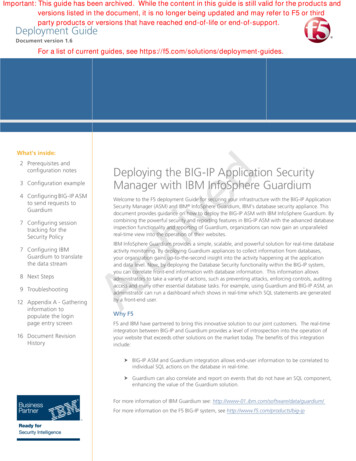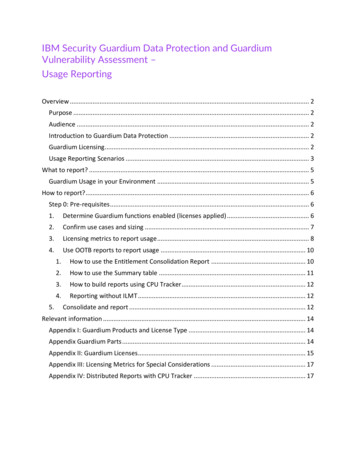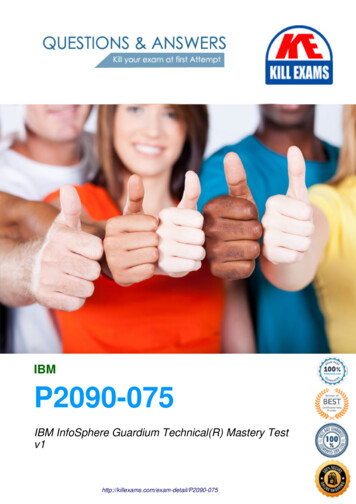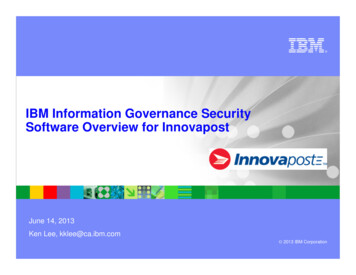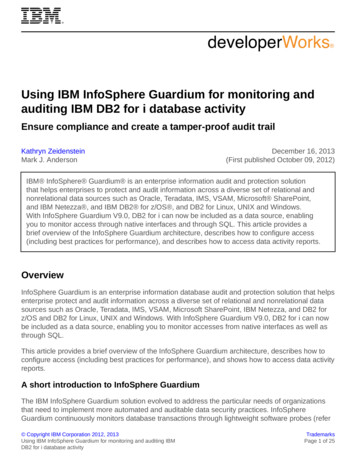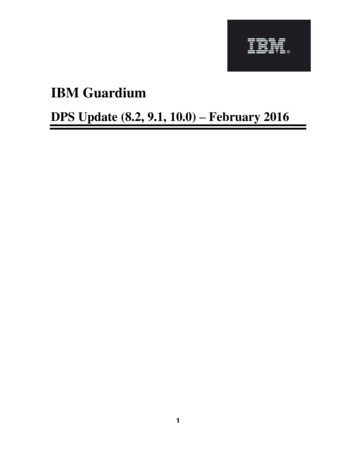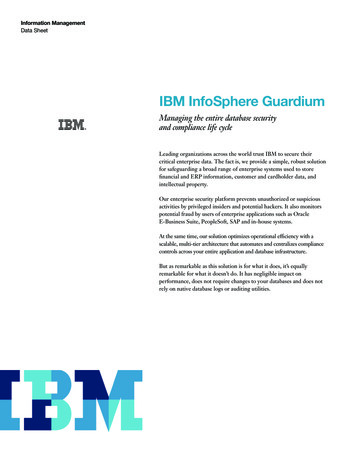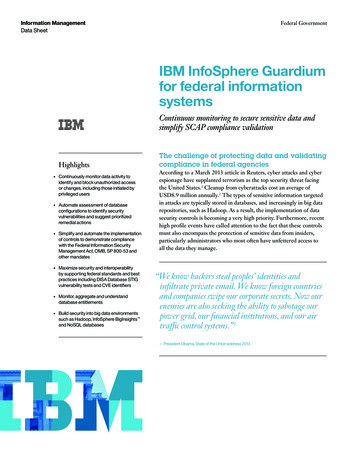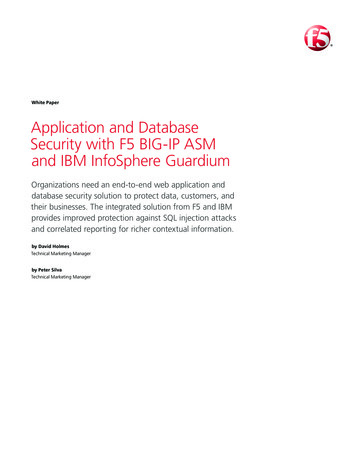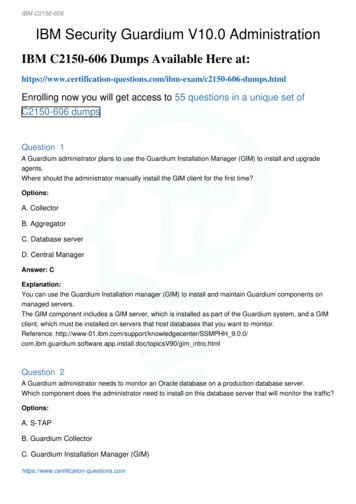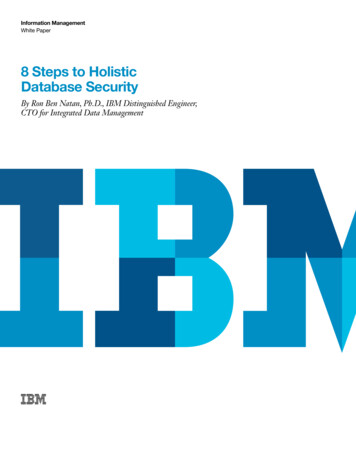
Transcription
Information ManagementWhite Paper8 Steps to HolisticDatabase SecurityBy Ron Ben Natan, Ph.D., IBM Distinguished Engineer,CTO for Integrated Data Management
28 Steps to Holistic Database SecurityCyberattacks, malfeasance by insiders and regulatory requirements aredriving organizations to find new ways to secure their corporate andcustomer data found in commercial database systems such as Oracle,Microsoft SQL Server, IBM DB2 and Sybase. This paper discusses the8 essential best practices that provide a holistic approach to bothsafeguarding databases and achieving compliance with key regulationssuch as SOX, PCI-DSS, GLBA and data protection laws.Safeguarding databasesand achieving complianceFinancially-motivated attacks, malfeasance by insiders andregulatory requirements are driving organizations to find newways to secure their corporate and customer data.Most of the world’s sensitive data is stored in commercialdatabase systems such as Oracle, Microsoft SQL Server, IBMDB2 and Sybase – making databases an increasingly favoritetarget for criminals. This may explain why SQL injection attacksjumped 134 percent in 2008, increasing from an average of a fewthousand per day to several hundred thousand per day accordingto a recently-published report by IBM1.information security professionals are being tasked with ensuringthat corporate databases are secure from breaches andunauthorized changes.Here are 8 essential best practices that provide a holisticapproach to both safeguarding databases and achievingcompliance with key regulations such as SOX, PCI DSS, GLBAand data protection laws:1. Discovery. You can’t secure what you don’t know. You need to have a goodmapping of your sensitive assets – both of your databaseinstances and your sensitive data inside the databases. Plus, youshould automate the discovery process since the location ofsensitive data is constantly changing due to new or modifiedapplications, mergers and acquisitions, etc.To make matters worse, Forrester2 reports that 60 percent ofenterprises are behind in applying database security patches,while 74 percent of all Web application vulnerabilities – whichare predominantly SQL Injection vulnerabilities – disclosed in2008 did not even have an available patch by the end of 2008,according to IBM.“You can’t secure what you don’t know. You needgood mapping of your sensitive assets — both ofyour database instances and your sensitive datainside your databases.”Figure 1: Using discovery tools to bootstrap an implementation. You need tomap database instances as well as where your sensitive data is located.Whereas most attention has previously been focused on securingnetwork perimeters and client systems (firewalls, IDS/IPS,anti-virus, etc.), we are now entering a new phase where1 “IBM Internet Security Systems X-Force 2008 Trend & Risk Report,” IBM Global Technology Services, Jan. 2009.2 “Market Overview: Database Security,” Forrester Research, Feb. 2009.
Information Management In an interesting twist, some discovery tools can also findmalware placed in your database as a result of SQL injectionattacks. In addition to exposing confidential information, SQLinjection vulnerabilities allow attackers to embed other attacksinside the database that can then be used against visitors to thewebsite.3. Hardening.2. Vulnerability and Configuration Assessment. Once you’ve created a hardened configuration, you mustcontinually track it to ensure that you don’t digress from your“gold” (secure) configuration. You can do this with changeauditing tools that compare snapshots of the configurations (atboth the operating system level and at the database level) andimmediately alert you whenever a change is made that couldaffect the security of the database. You need to assess the configuration of your databases to ensurethey don’t have security holes. This includes verifying both theway the database is installed on the operating system (forexample, checking file privileges for database configuration filesand executables) and configuration options within the databaseitself (such as how many failed logins will result in a lockedaccount, or which privileges have been assigned to criticaltables). Plus, you need to verify that you’re not runningdatabase versions with known vulnerabilities.3 The result of a vulnerability assessment is often a set of specificrecommendations. This is the first step in hardening thedatabase. Other elements of hardening involve removing allfunctions and options that you do not use.4. Change Auditing. Traditional network vulnerability scanners weren’t designed forthis because they don’t have embedded knowledge aboutdatabase structures and expected behavior, nor can they issueSQL queries (via credentialed access to the database) in orderto reveal database configuration information.Figure 3: Use case for database activity monitoring (DAM) and auditing.5. Database Activity Monitoring (DAM). Real-time monitoring of database activity is key to limitingyour exposure by immediately detecting intrusions and misuse.For example, DAM can alert on unusual access patternsindicating a SQL injection attack, unauthorized changes tofinancial data, elevation of account privileges, and configurationchanges executed via SQL commands.Figure 2: Vulnerability assessment and change tracking use case. Monitoring privileged users is also a requirement for datagovernance regulations such as SOX and data privacyregulations such as PCI DSS. It’s also important for detectingintrusions, since attacks will frequently result in the attackergaining privileged user access (such as via credentials owned byyour business applications).
48 Steps to Holistic Database Security DAM is also an essential element of vulnerability assessment,because it allows you to go beyond traditional staticassessments to include dynamic assessments of “behavioralvulnerabilities” such as multiple users sharing privilegedcredentials or an excessive number of failed database logins.“ Not all data and not all users are createdequally. You must authenticate users,ensure full accountability per user, and manageprivileges to limit access to data.” Finally, some DAM technologies offer application-layermonitoring, allowing you to detect fraud conducted viamulti-tier applications such as PeopleSoft, SAP and Oraclee-Business Suite, rather than via direct connections to thedatabase.7. Authentication, Access Control and EntitlementManagement. Not all data and not all users are created equally. You mustauthenticate users, ensure full accountability per user, andmanage privileges to limit access to data. And you shouldenforce these privileges – even for the most privileged databaseusers. You also need to periodically review entitlement reports(also called User Right Attestation reports) as part of a formalaudit process.8. Encryption. Use encryption to render sensitive data unreadable, so that anattacker cannot gain unauthorized access to data from outsidethe database. This includes both encryption of data-in-transit,so that an attacker cannot eavesdrop at the networking layerand gain access to the data when it is sent to the databaseclient, as well as encryption of data-at-rest, so that an attackercannot extract the data even with access to the media files.6. Auditing. Secure, non-repudiable audit trails must be generated andmaintained for any database activities that impact securityposture, data integrity or viewing sensitive data. In addition tobeing a key compliance requirement, having granular audittrails is also important for forensic investigations. Most organizations currently employ some form of manualauditing utilizing traditional native database loggingcapabilities. However, these approaches are often found to belacking because of their complexity and high operational costsdue to manual efforts. Other disadvantages include highperformance overhead, lack of separation of duties (sinceDBAs can easily tamper with the contents of database logs,thereby affecting non-repudiation) and the need to purchaseand manage large amounts of storage capacity to handlemassive amounts of unfiltered transaction information. Fortunately, a new class of DAM solutions are now availablethat provide granular, DBMS-independent auditing withminimal impact on performance, while reducing operationalcosts via automation, centralized cross-DBMS policies andaudit repositories, filtering and compression.Figure 4: Managing the entire compliance lifecycle.
Information Management5About IBM InfoSphere Guardium8 Steps to Database Security1. Discovery2. Vulnerability & Configuration Assessment3. Hardening4. Change Auditing5. Database Activity Monitoring (DAM)6. Auditing7. Authentication, Access Control &Entitlement Management8. EncryptionAbout the AuthorDr. Ron Ben Natan commands more than 20 years of experiencedeveloping enterprise applications and security technology forblue-chip companies such as Merrill Lynch, J.P. Morgan, Inteland AT&T Bell Laboratories. Ron also served as a consultant indata security and distributed systems for Phillip Morris, MillerBeer, HSBC, HP, Applied Materials and the Swiss Armed Forces.An IBM GOLD consultant with a Ph.D. in computer science, Ronis an expert on distributed application environments, applicationsecurity, and database security. He has authored 12 patents as wellas 12 technical books including Implementing Database Security andAuditing (Elsevier Digital Press), the standard text in the field, andRon’s newest book HOWTO Secure and Audit Oracle 10g and 11g(CRC Press) published in 2009.InfoSphere Guardium is the most widely-used solution forpreventing information leaks from the data center and ensuringthe integrity of enterprise data. It is installed in more than 400customers worldwide, including 5 of the top 5 global banks; 4 ofthe top 6 insurers; top government agencies; 2 of the top 3retailers; 20 of the world’s top telcos; 2 of the world’s favoritebeverage brands; the most recognized name in PCs; a top 3 automaker; a top 3 aerospace company; and a leading supplier ofbusiness intelligence software. InfoSphere Guardium was thefirst solution to address the core data security gap by providing ascalable, cross-DBMS enterprise platform that both protectsdatabases in real-time and automates the entire complianceauditing process.Guardium is part of IBM InfoSphere; an integrated platform fordefining, integrating, protecting and managing trustedinformation across your systems. The InfoSphere Platformprovides all the foundational building blocks of trustedinformation, including data integration, data warehousing, masterdata management, and information governance, all integratedaround a core of shared metadata and models. The portfolio ismodular, allowing you to start anywhere, and mix and matchInfoSphere software building blocks with components from othervendors, or choose to deploy multiple building blocks togetherfor increased acceleration and value. The InfoSphere Platformprovides an enterprise-class foundation for information-intensiveprojects, providing the performance, scalability, reliability andacceleration needed to simplify difficult challenges and delivertrusted information to your business faster.
Copyright IBM Corporation 2010IBM CorporationRoute 100Somers, NY 10589US Government Users Restricted Rights - Use, duplication ofdisclosure restricted by GSA ADP Schedule Contract with IBM Corp.Produced in the United States of AmericaMay 2010All Rights ReservedIBM, the IBM logo, ibm.com, Guardium and InfoSphere aretrademarks of International Business Machines Corporation,registered in many jurisdictions worldwide. Other product andservice names might be trademarks of IBM or other companies. Acurrent list of IBM trademarks is available on the web at “Copyrightand trademark information” at ibm.com/legal/copytrade.shtmlPlease RecycleInfoSpheresoftware IMW14277-CAEN-01
About IBM InfoSphere Guardium InfoSphere Guardium is the most widely-used solution for preventing information leaks from the data center and ensuring the integrity of enterprise data. It is installed in more than 400 customers worldwide, including 5 of the top 5 global banks; 4 of the top 6 insurers; top government agencies; 2 of the top 3
